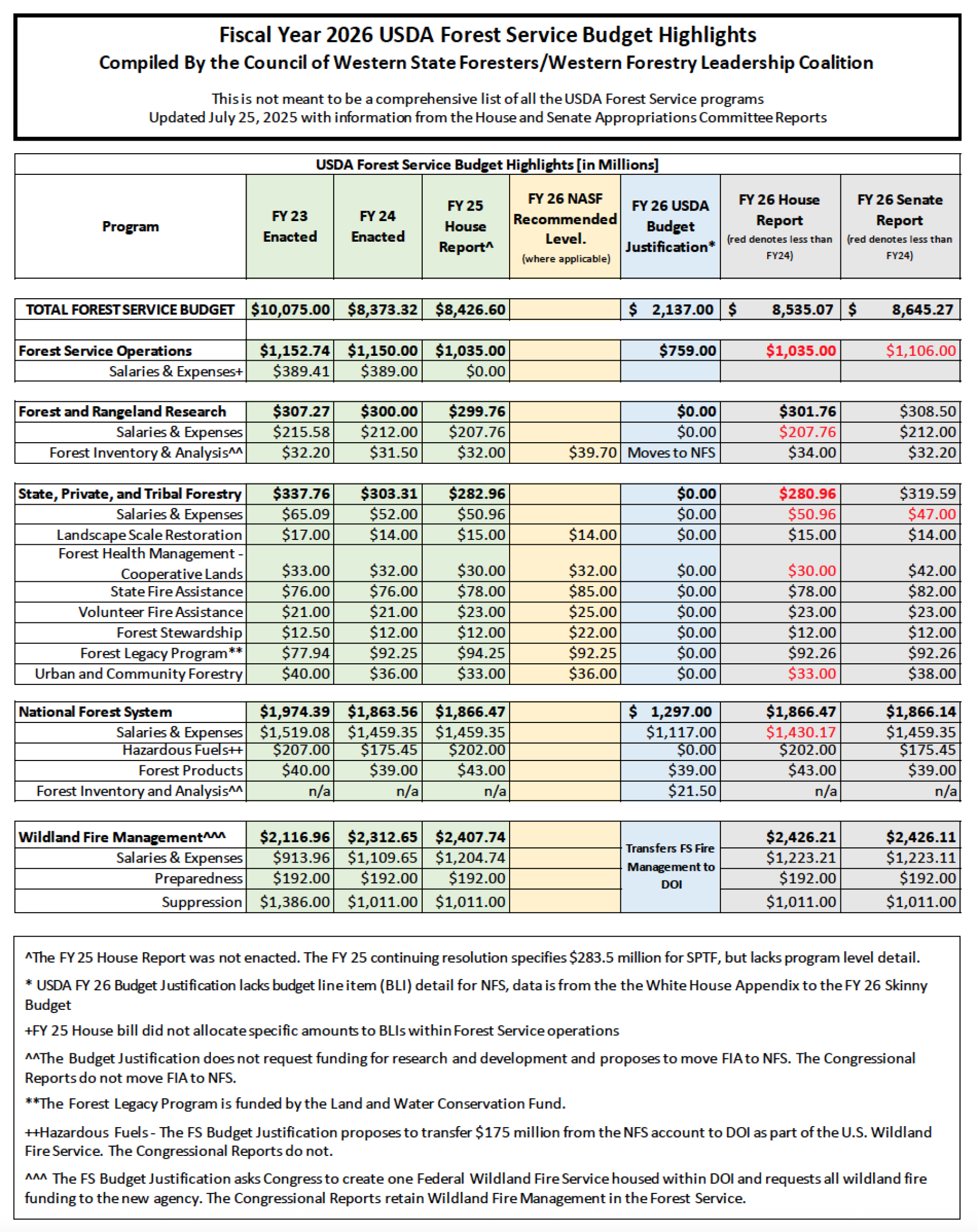(To download a PDF of the Policy Update, please visit our publication library.)
Read the latest policy update from Neil Simpson, CWSF/WFLC Director of Policy. This month’s policy update covers:
- Improving Oversight of Federal Grantmaking Executive Order
- Forest Legacy, Fire Coordination, Biochar, and Wildfire Smoke Legislation
- Wyoming Governor Signs Executive Order to Increase Active Forest Management
- Concern Over Revenue Sharing in Long-term Timber Sale Contracts
- Update on Michael Boren’s Nomination for USDA Under Secretary of Natural Resources and Environment
- Fiscal Year (FY) 2026 Appropriations Update
Improving Oversight of Federal Grantmaking Executive Order
On August 7, 2025, President Trump issued the Improving Oversight of Federal Grantmaking Executive Order (EO). The order aims to ensure the efficacy of federally funded projects, strengthen oversight and coordination, streamline agency grantmaking, and ensure greater accountability.
To accomplish this, it requires each federal agency head to designate a senior appointee who is responsible for:
- Creating a process to review funding announcements and grants to ensure they are consistent with agency priorities, national interest, and demonstrably advance the President’s policy priorities.
The order also declares that federal grants “shall not be used to fund, promote, encourage, subsidize, or facilitate:
- racial preferences or other forms of racial discrimination by the grant recipient, including activities where race or intentional proxies for race will be used as a selection criterion for employment or program participation;
- denial by the grant recipient of the sex binary in humans or the notion that sex is a chosen or mutable characteristic;
- illegal immigration; or
- any other initiatives that compromise public safety or promote anti-American values.”
Forest Legacy, Fire Coordination, Biochar, and Wildfire Smoke Legislation
Legislation Introduced to Make Changes to the Forest Legacy Program
Senator Padilla (D-CA) and Representative Garamendi (D-CA) have reintroduced the bicameral Forest Legacy Management Flexibility Act.
The bill would allow states to designate accredited, nonprofit land trusts to hold conservation easements purchased through the USDA Forest Service (Forest Service), Forest Legacy Program. Current law authorizing the program requires that only federal or state governments hold conservation easements purchased under the Forest Legacy Program.
S. 2556 is cosponsored by Senator Sheehy (R-MT) and has been referred to the Senate Agriculture, Nutrition, and Forestry Committee. H.R. 2771 has nine cosponsors and has been referred to the House Agriculture Committee.
Legislation Introduced to Create an Under Secretary for Fire Coordination
Representative Harder (D-CA) and cosponsor Valadao (R-CA) have introduced H.R. 4852, the Wildfire Emergency Preparedness Act of 2025. The bill would:
- Establish a presidentially appointed Under Secretary of Agriculture for Fire Coordination to serve as the principal adviser to the Secretary of Agriculture for any matter that relates to the coordination of federal, state, and local governments in preparing for, and responding to wildfires and wildland-urban interface (WUI) fires.
- Require the Forest Service to publish a plan to train structural firefighters to respond to wildfires and fires in the WUI and authorize grants to eligible entities to carry out the training programs.
- Require the Secretary of Agriculture and Interior to ensure a “national labor organization representing State and local firefighters” is represented on the Wildland Fire Leadership Council and the National Wildfire Coordinating Group.
- Authorizes a program to award competitive grants to fire departments to protect the health and safety of firefighters and the public.
Legislation Introduced to Establish a National Biochar Research Network
Senators Grassley (R-IA), Heinrich (D-NM), and Representatives Miller-Meeks (R-IA) and Pingree (D-ME) reintroduced legislation to study the effectiveness of biochar. The bicameral Biochar Research Network Act of 2025 would amend the Agricultural Research, Extension, and Education Reform Act of 1998 to create a national biochar research network to:
- Assess soil carbon sequestration with different uses of biochar.
- Understand how to use biochar productively for climate mitigation, crop production, ecosystem and soil health, farm profitability, and natural resource conservation.
- Deliver information to farmers, foresters, and other land managers.
H.R. 4764 has eight cosponsors and has been referred to the House Agriculture Committee. Heinrich (D-NM) is the sole cosponsor of S. 2450, which has been referred to the Senate Agriculture, Nutrition, and Forestry Committee.
View the press release.
Legislation Introduced to Protect School Children From Wildfire Smoke
Representative Dexter M.D. (D-OR) has introduced the Shielding Students From Wildfire Smoke Act. The bill directs the Administrator of the Environmental Protection Agency to contract with the National Academies of Sciences, Engineering, and Medicine to review existing policies addressing smoke exposure to children in schools and daycare facilities.
View the press release with links to a one-pager and bill text.
Wyoming Governor Signs Executive Order to Increase Active Forest Management
On August 1, 2025, Wyoming Governor Mark Gordon signed an EO titled Increase of Active Forest Management in Wyoming. The order recognizes that 48% of Wyoming is federal land and most of the state's forests are on federal land. Additionally, federal land management agencies and the state “heavily rely” on local fire cooperators to assist in fire suppression response. The order also states the Wyoming State Forestry Division (WSFD) provides “the essential expertise to prioritize, plan, and coordinate timber harvesting and watershed restoration work across all of Wyoming’s forests.”
At the signing, Wyoming State Forester Kelly Norris emphasized the importance of close state, federal, and local coordination to reduce wildfire risk, improve forest health, and support Wyoming's forest products industry. WSFD uses Good Neighbor Authority as its primary tool to increase active management, and plans to treat about 25,000 acres with 43 projects in 2025.
Concern Over Revenue Sharing in Long-term Timber Sale Contracts
Section 50301 of the One Big Beautiful Bill directs the Secretaries of Agriculture and Interior to enter into multiple long-term timber sale contracts of at least 20 years. The bill states that any monies derived from long-term contracts will be deposited in the general fund of the U.S. Treasury. This has led to concerns that monies from these timber sales will not be included in traditional revenue sharing with counties.
Senator Wyden (D-OR) voiced this concern in separate letters to Forest Service Chief Tom Schultz and Acting Bureau of Land Management Director Bill Groffy. In his letter to Chief Schultz, Senator Wyden writes that directing monies from these contracts to the general treasury “is not incompatible with 16. U.S.C. 500,” which mandates that 25% of revenue derived from a National Forest be returned to counties for the benefit of public schools and roads. In his letter to Acting Director Groffy, Wyden similarly states the language in the One Big Beautiful Bill “does not demonstrate a clear intent by Congress to override the revenue sharing requirements in the O&C Act.” Wyden requests Groffy and Schultz to provide a written response by September 8, stating their intent to continue revenue sharing under these newly required long-term timber sale contracts.
View Senator Wyden’s press release.
Michael Boren’s Nomination for USDA Under Secretary of Natural Resources and Environment Clears the Senate Agriculture, Nutrition, and Forestry Committee.
In a July 28, 2025, Business Meeting, the Senate Agriculture, Nutrition, and Forestry Committee voted to advance Michael Boren’s Nomination for USDA Under Secretary of Natural Resources and Environment. Twelve Republicans voted to advance the nomination, while all 11 Democrats on the committee voted against the nomination, with committee Ranking Member Klobuchar (D-MN) citing concerns about Mr. Boren’s background as the reason all democrats voted against the nomination.
No date has been set for a final Senate floor vote on Mr. Boren’s nomination.
Fiscal Year (FY) 2026 Appropriations Update
The House and Senate Appropriations Committees have each passed versions of the Interior, Environment, and Related Agencies Appropriations bills for 2026. It is now up to each chamber to pass these bills with a floor vote and reconcile the differences between the two versions for final passage. However, debates over FY 25 rescissions, earmarks, nominations, and spending levels make it very unlikely Congress will pass the 12 funding bills needed to fund the government by the September 30 deadline. Currently, it is expected that Congress will pass a short-term continuing resolution to avoid a government shutdown and provide themselves more time to pass FY 26 appropriations.
Both the House and Senate chose not to consolidate wildland fire budgets in the Department of the Interior, as requested by the agencies’ budget requests. Read a synopsis of House report language in the July 2025 Policy Update.
A few highlights from the Senate Report include:
- The Forest Service and Department of the Interior must report to the Committee on current wildfire capacity and needs, how they would consolidate programs, and anticipated costs to implement the Empowering Commonsense Wildfire Prevention and Response EO.
- The Committee supports the current structure consisting of the five regional research stations, the International Institute of Tropical Forestry, and the Forest Products Laboratory, and directs that each of the existing facilities and programs be funded at least at the FY 24 enacted level.
- The Committee recognizes the integral relationship between the Forest Service and state forestry agencies. It directs the Forest Service to coordinate with state forestry agencies to establish performance measures for State, Private, and Tribal Forestry programs.
- It directs the Forest Service to work collaboratively across deputy areas to define and expand performance based performance measures.
The following table details select Forest Service appropriations. View the Senate and House bills and accompanying reports and follow the progress of all 12 appropriations bills on Congress.gov.

